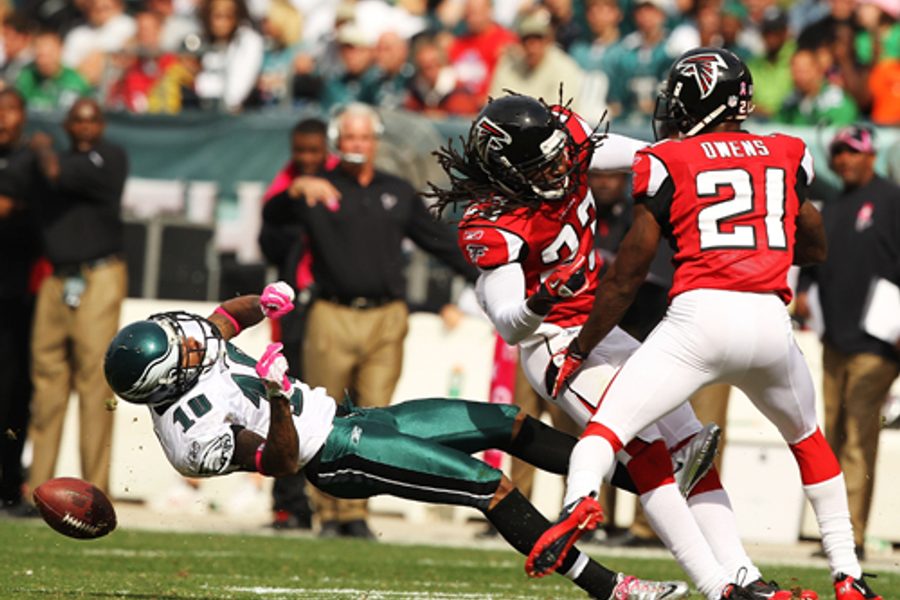
On Wednesday, the National Football League announced tough new penalties for violent hits, like the brutal helmet-to-helmet hit that left the Eagles DeSean Jackson lying on the field for several minutes. Players who deliver illegal blows to the head and neck will face large fines and suspensions. The player who hit Jackson will be fined $50,000, a huge sum by NFL standards.
All of a sudden, the NFL wants to look tough on concussions. This is less a matter of compassion and more an issue of self-preservation.
For years, the league denied there was any connection between repeated blows to the head and early-onset dementia. At this point, the scientific evidence is so overwhelming that continuing to deny the obvious could leave the league open to lawsuits by players who were deceived about the risks.
In late July, the league abruptly acknowledged the facts on the ground and posted concussion warning notices in players’ lockerrooms, acknowledging the link between repeated concussions cognitive decline. The NFL’s lawyers probably realized that, in the face of such overwhelming scientific evidence, denial was a bigger liability than acceptance.
NFL football players with a history of concussions are at risk of an incurable brain disease called chronic traumatic encephalopathy (CTE). Repeated brain bruises (aka “concussions”) literally scar the brain. Symptoms include memory loss, depression, confusion, and fits of uncontrollable rage. In most cases, the true toll of the CTE doesn’t become apparent for several years after the player retires.
After former Eagles defensive back Andre Waters died of a self-inflicted gunshot wound in 2007 at the age of 44, a forensic pathologist found that his brain resembled that of an 85-year-old. The brain was shrunken and shot through with abnormal tau protein, the biological marker that sets traumatic encephalopathy apart from Alzheimer’s disease.
That year, the NFL and the Players’ Association jointly founded the 88 Plan, which helps retired players with dementia pay their medical bills. Many observers worry that eligible retirees aren’t benefiting because they are already to impaired to apply.
To date, neuroanatomists have performed autopsises on 13 former professional football players who died after exhibiting signs of degenerative brain disease, 12 of these players were found to have suffered from CTE. Recently, signs of early CTE were found in the brain of a college player with a history of concussions who committed suicide during a bout of depression.
A survey of 1000 randomly selected retired NFL players with a history of concussions found that 6.1% of respondents said they’d had been diagnosed with dementia, a rate five times higher than for people the same age in the general population.
The NFL’s crackdown on violent hits probably won’t do much to stem the epidemic of post-concussion dementia. That’s because the worst damage doesn’t necessary come from the most spectacular hits.
Researchers at the University of North Carolina installed accelerometers in the helmets of college players to measure the g-forces acting on their brains. As Malcolm Gladwell explains, the sensors show that players are regularly subjected to g-forces strong enough to cause brain damage during practice:
When we think about football, we worry about the dangers posed by the heat and the fury of competition. Yet the HITS data suggest that practice — the routine part of the sport — can be as dangerous as the games themselves. We also tend to focus on the dramatic helmet-to-helmet hits that signal an aggressive and reckless style of play. Those kinds of hits can be policed. But what sidelined the U.N.C. player, the first time around, was an accidental and seemingly innocuous elbow, and none of the blows he suffered that day would have been flagged by a referee as illegal. Most important, though, is what Guskiewicz found when he reviewed all the data for the lineman on that first day in training camp. He didn’t just suffer those four big blows. He was hit in the head thirty-one times that day. What seems to have caused his concussion, in other words, was his cumulative exposure.
Better helmets probably won’t solve the problem, either. The helmet cushions outside of the head, but it doesn’t stop the brain from bashing against the cranium when the player stops suddenly.
The UNC concussion research suggests that returning to the game before a concussion is especially dangerous. Sustaining a second blow before recovering from the first is far more damaging than either blow in isolation.
There’s not a lot the NFL can do about the physics of large guys crashing into each other, or the fragility of the human nervous system. However, the NFL can do something about the culture of playing hurt.
Pushing through pain is always going to be a part of sports. It’s one thing to do a cost-benefit analysis and play with a sore knee or a wrenched back. Maybe it’s not what a doctor would recommend, but sometimes that’s what the game demands. The price might be a shorter career, or a less spry retirement. Professional athletes are more than willing to make that tradeoff.
We now know that concussions are a qualitatively different kind of threat. The standard cost/benefit analysis doesn’t apply. The stakes are much higher. We’re not talking about punishing the body, we’re talking about annihilating the self.
Discouraging players from playing with concussions is one of the few things the NFL could do to mitigate the toll the sport takes on the brains of players.
The NFL and the Players’ Association need to support a cultural shift when it comes to playing through concussions.







